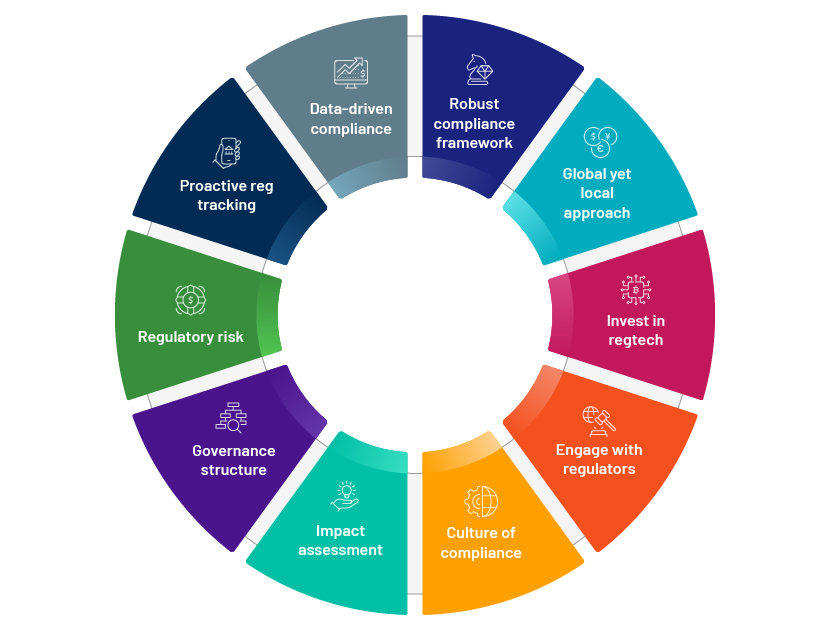Published on November 12, 2024 by Puneet Prakash and Suresh Chavali
Highly regulated sectors, such as the asset management sector, are constantly trying to manage the dynamic global regulatory environment. This continues to exert pressure on them from regulators, investors, counterparties and other market players to remain compliant. Regulations can affect asset managers in multiple ways, including via the rising cost of compliance, changes in operational procedures and risk management structures, and the focus on sustainable investment decisions.
It is imperative that the leaders of asset management firms understand these regulations in order to minimise risks and ensure investor confidence. This requires the right balance between legal aspects, efficient internal controls and effective compliance. This blog looks at the various ways in which CXOs can tackle these regulatory issues.
Before we delve into effective strategies for navigating these regulations, we provide below an overview of regional and global regulations that asset managers need to comply with.
| S.no. | Regulation | Scope | Key requirements for asset managers |
| 1. | MiFID II (Markets in Financial Instruments Directive II) – Europe | Applies to investment firms, trading venues and data reporting service providers in the European Union (EU) | Improve transparency, enhance investor protection, comply with stringent reporting provisions and implement product governance rules. This also affects research unbundling and trading activities. |
| 2. | AIFMD (Alternative Investment Fund Managers Directive) – Europe | Governs the management, administration and marketing of alternative investment funds (AIFs) in the EU | National regulators require maintaining capital, managing risks, managing liquidity and presenting information. |
| 3. | UCITS (Undertakings for Collective Investment in Transferable Securities) – Europe | A regulatory framework for the sale of cross-border investment funds in the EU | Stringent requirements on diversification, liquidity, leverage and disclosure. Compliance with governance and risk management standards relating to funds. |
| 4. | Dodd-Frank Wall Street Reform and Consumer Protection Act – US | Comprehensive financial regulation in the US governing AMs, particularly those dealing with derivatives and hedge funds | Improve transparency in the derivatives markets, register hedge funds with the SEC and comply with the Volcker Rule limitations on proprietary trading and investments in covered funds. |
| 5. | SEC (Securities and Exchange Commission) regulations – US | Governs asset management firms registered with the SEC | Rules in place include the Investment Advisers Act, Form ADV, fiduciary duties, advertisement rules and anti-fraud rules. |
| 6. | GDPR (General Data Protection Regulation) – Europe | Applies to any organisation that processes the personal data of EU citizens, including asset managers | Strict rules on data protection, privacy and the processing of personal data. Asset managers to ensure that they have appropriate consent, data handling and security measures in place. |
| 7. | EMIR (European Market Infrastructure Regulation) – Europe | Regulates over-the-counter (OTC) derivatives, central counterparties (CCPs) and trade repositories (TRs) within the EU | Clearing of specific derivatives, reporting of trade transactions to trade repositories and mandatory minimum measures for non-centrally cleared transactions. |
| 8. | Basel III – Global | A global regulatory framework for banks and financial institutions, including those involved in asset management activities | Tighter capital rules and measures of leverage and liquidity in financial companies can affect the business models and funding of asset managers |
| 9. | AML/CFT (Anti-Money Laundering and Countering the Financing of Terrorism) regulations – Global | Global regulations aimed at preventing money laundering and terrorist financing; applicable to asset managers | Adhering to customer due diligence requirements, reporting suspicious activities and maintaining compliance with national and international AML/CFT regulations. |
| 10. | PRIIPs (Packaged Retail and Insurance-based Investment Products) regulation – Europe | Applies to manufacturers of PRIIPs and those advising on or selling these products in the EU | Development and delivery of a key information document (KID) for every PRIIP that will explain to retail investors the risks, charges and possible returns on their investments. |
| 11. | FCA (Financial Conduct Authority) regulations – UK | Governs asset management firms operating in or providing services to clients in the UK | Meeting the rules on governance, conduct and transparency set by the FCA, as well as some rules such as the SM&CR. |
| 12. | APRA (Australian Prudential Regulation Authority) regulations – Australia | Oversees financial institutions in Australia, including asset managers | Adherence to APRA governance, risk management and financial soundness standards. |
| 13. | Japan’s FIEA (Financial Instruments and Exchange Act) – Japan | Regulates the securities market in Japan, including asset management activities | Compliance with registration requirements, conduct rules and disclosure obligations under the FIEA. |
| 14. | MAS (Monetary Authority of Singapore) regulations – Singapore | Regulates financial institutions in Singapore, including asset management firms | Compliance with MAS regulations on fund management, including licensing, capital requirements and anti-money-laundering measures. |
| 15. | Hong Kong’s SFO (Securities and Futures Ordinance) – Hong Kong | Regulates the securities and futures markets in Hong Kong | Must be licensed by the Securities and Futures Commission (SFC) and also meet conduct, disclosure and risk management requirements. |
By following these and other regulations and keeping themselves up to date, asset managers would be able to avoid risks, operate efficiently and gain the trust of clients and regulatory bodies globally.
Playbook for asset management CXOs
Amid increasing regulation, CXOs need to have robust compliance programmes in place. The following is a simple action plan, with a focus on some of the major steps.

1. Develop a robust compliance framework
-
Establish compliance divisions that would be in charge of compliance across the world and work with offices in other regions to meet both international and regional compliance standards
-
Standardise procedures to ensure consistency and ease of adaption at the local level
2. Maintain a global yet local approach
Global standards with local adaptation: While keeping policies on par with international standards, ensure that the policies are not rigid to the extent that they cannot be adapted to meet the requirements of local jurisdictions
-
Leverage local legal and compliance experts with expertise in regional regulations. This ensures that the firm is well versed in local requirements
3. Invest in regulatory technology (regtech)
-
Integrating regtech is essential for asset managers navigating complex regulations. Automation of reporting and compliance monitoring not only enhances efficiency but also reduces the risk of human error
-
Clients adopting regtech for investment compliance and marketing material reviews have reported positive outcomes, but there is still much ground to cover in terms of fully utilising these solutions. As regulations evolve, leveraging regtech would be crucial for firms to adapt swiftly and maintain robust compliance frameworks, ensuring their competitiveness in a highly regulated sector
4. Engage with regulators to gain insights on upcoming regulatory changes and future trends
-
Maintain open and regular communication with regulatory bodies across relevant jurisdictions
-
Participate in industry associations and groups that interact with regulators to get early warnings about upcoming regulatory changes
5. Build and maintain a culture of compliance
-
Ensure that firm-wide compliance is a continuous process where the need for compliance is repeated frequently across the firm
-
Implement continued training programmes for employees at all levels to ensure they are up to date with the latest regulatory requirements and compliance practices
6. Assess impact and prioritise
-
Assess the effects of regulations on operations and focus on projects that help achieve objectives
-
Conduct regular scenario planning exercises and compliance simulations to prepare teams for potential regulatory challenges and audits
7. Deploy flexible and scalable governance structures
-
Deploy a governance framework able to quickly adopt policies and procedures as regulations evolve
-
Establish a cross-functional team of legal, compliance, risk management and operations personnel that can provide a holistic view of regulatory impacts
8. Include regulatory risk as part of enterprise risk management
-
Implement integrated risk management systems that consider regulatory risk as part of the broader enterprise risk management framework; this would help in better identification, assessment and mitigation of regulatory risk
9. Implement a proactive regulatory radar
-
Ensure that the systems in place monitor regulatory changes across the world and adapt as soon as possible
10. Build a data-driven compliance programme
-
Use data analytics to identify patterns, trends and anomalies in compliance data, helping to spot potential regulatory issues before they become critical
-
Regularly conduct stress tests and scenario analyses to assess the firm’s resilience to regulatory changes and identify areas of vulnerability
Conclusion
To CXOs in asset management, compliance is not just a checklist item to tick, but a vital business imperative. With this mindset, firms would not only be compliant but also succeed in the long term; this would be enabled by being aware of the global regulatory context, following a strict compliance plan and targeting the right regulatory changes.
How Acuity Knowledge Partners can help
We are a trusted partner to asset managers globally, offering a unique blend of people and technology to streamline compliance functions and mitigate regulatory risks. Our approach integrates deep domain expertise with advanced regtech solutions, providing asset managers with managed services and technology-driven tools to navigate complex regulatory environments.
Our Data Technology Solutions (DTS) team works closely with compliance professionals who deeply understand client needs to build tailored regtech solutions. This collaboration ensures that our tools are designed to address the specific compliance challenges faced by asset managers.
We have developed two flagship tools: GCM (Guideline Compliance Manager) and BEAT AdInspect. GCM automates the investment guideline coding process, and BEAT AdInspect streamlines the process of compliance review of marketing materials. Together they offer seamless compliance management and help asset managers stay ahead of global regulatory demands.
By leveraging our managed services model and cutting-edge technology, asset managers can efficiently meet regulatory requirements while focusing on their core business.
Sources:
Tags:
What's your view?
About the Authors
Puneet Prakash is the product head of the firm’s Compliance Services business unit. He is responsible for strategizing and creating optimal solutions for the firm’s Compliance clientele, globally. He has over 15 years of experience in financial services and knowledge offshoring. He has previously worked with firms such as TCS and WNS. Puneet holds an MBA (Finance & Marketing) from the Indian Institute of Management, Kozhikode and a Bachelor of Technology from the Indian Institute of Technology, India
Suresh Chavali has over 11 years of experience in compliance, having worked for various firms including Barclays and Deutsche Bank. His expertise spans across the risk and compliance sector, focusing on know your customer (KYC) and risk management. At Acuity Knowledge Partners he is responsible for Pre-sales and Product Management support to Compliance Services. Suresh has done his engineering from JNTU Hyderabad.
Like the way we think?
Next time we post something new, we'll send it to your inbox












